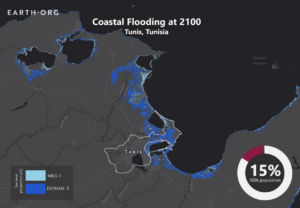Oct
6
A Review of “A Siege of Salt and Sands”: The Effects of Climate Change on Tunisia and MENA
October 6, 2023 | | Leave a Comment
The Middle East and North Africa is the most water-scarce region in the world and one of the most food insecure as well, which is only made worse by the constant economic instability and increasing effects of climate change. “A Siege of Salt and Sands” takes Tunisia as a case study of the previous issues in regard to climate change, focusing on both coastal city life and the desert climate to the south. The documentary does a good job of tying political issues to the worsening effects of climate change by addressing the start of the Arab Spring in 2010. While the Arab Uprising in Tunisia was generally focused on economic stagnation with the negative effects of structural adjustment and political corruption, the government’s lack of action on the environment has contributed to the frustration of many Tunisians.

Earth.org
Looking first at “the Salt”, or coastal towns, Kerkennah and Djerba provide evidence of the impacts of climate change both in rising sea levels and in droughts. The documentary shows many civilians in the towns, including fishermen who make their living off of the sea. They claim that in two years there will be no fish left and that droughts have killed 65% of the date palms in their town. Additionally, with no rain in over a year when the film was taken, this affects not only crop production but also access to drinking water as that is a major source for many. Regarding sea levels, they have risen 25-30 cm since the effects of climate change were first seen in the region. The people worry about losing their homes and even Kerkennah turning into inlets soon, as demonstrated by the projected effects of rising sea levels in the map.
Further south, “the Sands” are also experiencing the effects of climate change and the resulting droughts through increasing desertification. Much like in the north, the seasons have changed to be much warmer and windier, with little to no rain. Some areas hadn’t seen rain in three years. The already dry environment is only becoming drier and sand is encroaching on many towns, getting into houses, covering fertile land, and paralyzing the development of the region. This desertification poses a serious threat as 64% of Tunisia’s surface is threatened by desertification and 23% of that has already been desertified. Water access is a prominent issue as well, with families being forced to choose to water their crops or provide themselves with drinking water. One farmer included that wells are the solution but the government isn’t providing enough of them, instead making the civilians pay for water with money they don’t have. Even with water access, it tends not to be enough to irrigate entire fields, threatening the agricultural industry and the standard of living for many in the area.
The documentary highlights the complexity that climate change has brought to already damaging issues in the region such as water shortage, the struggling agricultural sector, and desertification. Given the political and economic context that has been covered in class, it’s clear how the interaction of these environmental issues has only been complicated by the structural adjustment of the region and the increasing pressure on the government. It also highlights some of the positive changes Tunisia has made towards the end, including being only the third country to include a clause about climate change in its constitution. This film overall does a great job at providing civilian and scientific accounts for the environmental struggles plaguing the nation and the resulting societal and economic impacts of them to help make the topic more digestible and personal than it traditionally is.
“A Siege of Salt and Sand”. Directed by Sam McNeil, produced by Sam McNeil and Radhouane Addala, 2014.
Cammett, Melani. A Political Economy of the Middle East. Available from: MBS Direct, (4th Edition). Taylor & Francis, 2018.